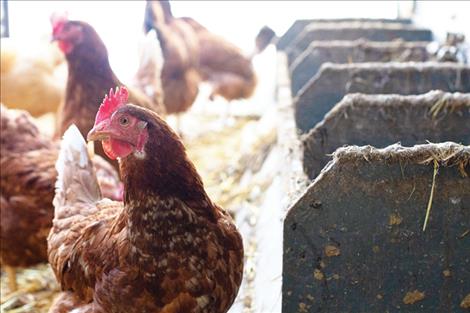Farm & Ranch
Local egg producers work to fill gap left by national distributors
Hey savvy news reader! Thanks for choosing local.
You are now reading
1 of 3 free articles.
LAKE COUNTY — In the wake of the national egg shortage, which has seen national providers across the board lose flocks of chickens to avian influenza, local egg providers have been rising to the challenge to meet increasing egg demand.
According to the U.S. Department of Agriculture, the United States suffered its deadliest outbreak of avian influenza between 2021 and 2022 with 50.54 million birds killed across 47 states. The prior record saw the death of 50.5 million birds in 2015. Data published by the USDA in January of this year showed that in December of 2022, the average number of “layers” was down 5% from 2021, and the overall production of eggs fell by 6.6%. At the end of 2022, inventories were 29% lower than at the start of the year.
“It’s been a rollercoaster, that’s for sure,” Emily Mayberry of the Western Montana Growers Cooperative commented. The co-op works with two egg producers in the area: the standard producer, Spencer Valley View Eggs west of Kalispell, and organic producer, Mission Mountain Organic Eggs in Ronan. The primary challenge they’ve seen, according to Mayberry, is availability.
“I’d say not only was the avian flu a challenge, but living and growing and producing in Montana is always a challenge,” Mayberry explained. “Not only are they dealing with culling, but they’re also dealing with weather changes. Last year was hard with a short spring and summer and an early winter. Birds are sensitive, and they had challenges … But they’re always able to produce, it’s just that availability changes based on all those factors.”
For their part, Mission Mountain Eggs hasn’t lost any birds to avian influenza. Thanks to the biosecurity measures they’ve had in place – only allowing certain people into the barns, wearing certain clothes and boots – and keeping the chickens inside instead of in a pasture for the last year, none of their birds have fallen ill.
However, due to the lack of eggs on local store shelves from larger and/or national providers, more and more people and businesses are looking to Mission Mountain Eggs for their eggs. “Our demand has skyrocketed,” Chase Walkup of Mission Mountain Eggs stated. “Normally people wouldn’t buy the more expensive eggs but when they’re the only eggs available on the shelf, they’re going to buy eggs.”
While Mission Mountain Eggs does its best to prioritize their direct supply of eggs to Super 1 in Polson, several grocery stores in the valley without that direct supply connection have reported running out of eggs from time to time in the last year. Shayna from Mission Mountain Natural Foods mentioned that more than once during the shortage acting as the middleman to connect those searching for eggs with locals with small-scale chicken operations.
Shelly Fyant with the Arlee Community Development Corporation (CDC), explained that a couple of times in February, due to a lack of egg supply, they had to limit food pantry clients to a dozen eggs per family.
“Eggs are really important to a lot of our clients. Some of them have dental issues and eggs are pretty soft and easy to eat, so we really miss them if they’re not there,” Fyant commented. She went on to say, as the CDC develops their community garden, in an effort to be more self-sufficient and active in the food chain, they would like to include in their long term plan chickens for eggs.
Data published by the USDA in January showed a slight increase in the number of egg-type pullet chicks for future hatchery supply flocks up 3% from the prior year. Broiler-type chicks for future domestic hatchery supply up 1%. This indicates there is work being done to restore the supply of “layer” chickens in the market. Local egg suppliers are optimistic, as well.
“From our experience – we’ve been doing this for 15 years – egg demand has seasons of real high demand and real low demand. I’ve got a feeling we’ll have probably a low demand for eggs again,” Walkup said. “It may take a couple years with the avian flu pandemic going on, but I’m sure everything will go back down again eventually.”
“There’s always those ongoing challenges for sure, but it is getting better. The plans they put in place to recover from avian flu, we’re seeing that beneficial move now. We’re starting to get more eggs available,” Mayberry commented. “We’re just excited to have more egg availability coming up soon, it’s right around the corner.”

















